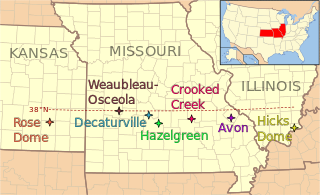
The 38th parallel structures, also known as the 38th parallel lineament, are a series of seven circular depressions or deformations stretching 700 kilometres (430 mi) across southern Illinois and Missouri and into eastern Kansas, in the United States, at a latitude of roughly 38 degrees north. Estimated at 300 million years old, two are believed to be impact events from meteorites, but other structures are possibly remnants of volcanos.
The following is a list of Registered Historic Places in Ottawa County, Michigan.
This National Park Service list is complete through NPS recent listings posted September 27, 2024.

The Earth Impact Database is a database of confirmed impact structures or craters on Earth. It was initiated in 1955 by the Dominion Observatory, Ottawa, under the direction of Carlyle S. Beals. Since 2001, it has been maintained as a not-for-profit source of information at the Planetary and Space Science Centre at the University of New Brunswick, Canada.
The 70th parallel south is a circle of latitude that is 70 degrees south of the Earth's equatorial plane in the Antarctic. The parallel passes through the Southern Ocean and Antarctica.
The Impact Field Studies Group (IFSG) was a scientific organization emphasizing geologic field research of suspected and confirmed sites of impact craters and impact structures. The group is composed of researchers, professionals and students involved in study of impact sites. IFSG's web site is hosted by the Department of Earth and Planetary Sciences at University of Tennessee, Knoxville.





